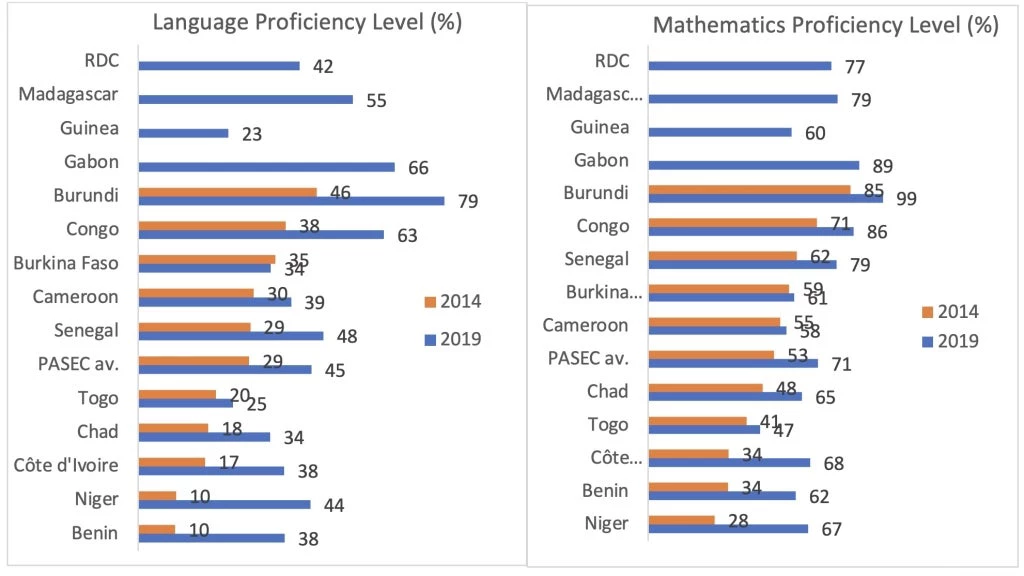 Students in grade 2, Kinama primary school. Photo: IngoMag
Students in grade 2, Kinama primary school. Photo: IngoMag
In 2005, Burundi embarked on an extraordinary mission to change its schooling system to ensure that all children, especially girls, had access to quality education. This small East African nation has since made impressive gains in building the foundational skills of its children by simultaneously expanding access to education and maintaining its quality at primary (elementary) level.
The introduction of free primary education in 2005 marked a turning point for Burundi, a bold move that opened doors to education for countless children across the country. The results have been remarkable, with the gross primary enrollment rate standing at 118.5% (2022), a huge increase from 58% in 2000.
Gross enrollment in lower secondary (junior high school) education has surged from 32% in 2010 to an encouraging 40.6% in 2022. During this period, the number of years of schooling Burundian children have has increased from 6.4 to 7.6 years.
Elevating quality education as a priority
Access to education alone is not enough. The Government of Burundi made strides in the quality of foundational learning by investing in high-quality instruction in children’s mother tongue, Kirundi, in early grades. There has also been commitment to building teams of qualified and dedicated teachers and to nurturing community engagement and support. The results of these initiatives are underscored by the 'Programme d'analyse des systèmes éducatifs de la CONFEMEN' (PASEC) student assessment, which attests to the fact that Burundian children shine in reading and mathematics, particularly in early grades, outperforming their peers in other Sub-Saharan African Francophone countries. The World Bank-funded Burundi Early Grade Learning Project (PAADESCO) has played a pivotal role in maintaining the quality of education by bolstering primary school curriculum, enhancing teaching and learning resources, extending school feeding programs, and providing essential school kits. Building on the successes of PAADESCO, the Human Capital Development Project, currently under preparation, aims to further advance reforms of the curriculum. It will concentrate on facilitating a smooth transition from Kirundi to French as the language of instruction, helping ensure uninterrupted learning.
Proficiency Trends in Language and Mathematics for Grade 2

Burundi’s Success in Bridging the Gender Gap
As Burundi expanded education, girls weren't left behind. Following the introduction of free primary education, girls' enrollment skyrocketed, culminating in gender parity in primary enrollment by 2011. In 2023, more girls than boys were enrolled in both primary and secondary (high) schools. Girls are expected to complete half a year more of schooling than their male counterparts.
In 2019, PASEC results showcased a remarkable trend: girls consistently surpassing boys in academic achievement in Burundi. Despite facing the highest repetition rates in primary and lower secondary education among neighboring and PASEC countries, girls have demonstrated resilience, experiencing fewer instances of grade repetition or dropout in recent years.
Burundi's progress in girls' education extends beyond the classroom. The female literacy rate, reaching nearly 75% among women aged 15–24, has been instrumental in motivating girls to pursue education. Today, young Burundian women marry at a later age than their counterparts in other East African countries, typically tying the knot at 23. Additionally, adolescent girls aged 15 to 19 have fewer children than their peers in other East African countries, with 54 pregnancies per 1,000 women in 2021.
Age at First Marriage and Adolescent Fertility Rates in Burundi

While Burundi's work in education is an inspiring one, challenges persist. The latest 2022-2023 statistical report brings attention to an unprecedented shift: girls now surpass boys in grade repetition for the first time in a decade. This development underscores the importance of analyzing factors contributing to girls' academic challenges, including the decline in female teachers from 80% to 57% over the past decade. In addition, only 41% of primary schools have access to a water source, and sanitation rates are low at one well-maintained latrine per 76 girls. About a third (34%) of schools lack proper latrines for girls completely. A high percentage of girls (70.2%) do not attend school during their menstrual periods, leading to an average of five days of absence a month. As a result, girls perform less favorably than their male counterparts around the onset of puberty in lower middle secondary school.
To tackle these gender disparities and improve the overall educational landscape, the new Human Capital Development Project, jointly led by education and health sectors, aims to implement initiatives such as promoting menstrual hygiene education, enhancing sanitation facilities, and providing menstrual products, among other essential measures.
Through well-crafted policies, investments in quality education, and commitment, Burundi has encouraged girls to do well in school, to excel academically, and to make informed life choices—a testament to the transformative power of education in unlocking opportunities and dismantling gender barriers.



Join the Conversation